Overview
In the fast-paced world of tech startups, many founders grapple with the daunting challenge of designing products that are both flexible and scalable. This struggle can lead to feelings of frustration and overwhelm, as the pressure to adapt to market changes intensifies. The implications of this challenge are significant; without a robust design strategy, startups risk losing their competitive edge and failing to meet customer expectations.
However, there is hope. By embracing modular design, startups can transform their approach to product development. Modular design breaks down complex products into manageable components, allowing for quicker responses to market shifts and enhancing overall efficiency. This not only leads to improved customer satisfaction but also fosters a culture of sustained innovation.
Imagine being able to pivot your product in response to user feedback without overhauling your entire system. This is the power of modular design. It empowers startups to be agile and responsive, ultimately creating a better experience for both the team and the customers. As you explore these strategies, remember that you are not alone on this journey. Many founders have walked this path and found success through the implementation of modular design. Together, we can navigate these challenges and build a brighter future for your startup.
Introduction
In the ever-evolving world of technology, many startups grapple with the challenges of product development and the need to adapt to market demands. It’s a struggle that can feel isolating and overwhelming. However, there is hope. By embracing modular design principles, startups can pave the way for innovation, creating flexible and scalable digital experiences that truly resonate with consumers. Yet, the journey isn’t without its hurdles—how can these startups effectively navigate the complexities of modularity while ensuring seamless integration and user satisfaction?
This article offers a compassionate exploration of seven essential strategies for designing with modularity, providing insights that could transform the product development approach for tech startups. Together, let’s discover the potential that lies within modularity and how it can support your vision.
RNO1: Leveraging Modular Design for Enhanced Digital Experiences
In today's fast-paced digital landscape, many tech startups struggle to adapt to ever-changing market demands and consumer preferences. This challenge can lead to frustration and stagnation, making it difficult for brands to connect with their audience effectively. At RNO1, we understand these pain points deeply. That's why we harness design for modularity principles to create flexible and scalable digital experiences tailored specifically for our clients. By utilizing a design for modularity, we break down intricate digital products into manageable modules, empowering brands to swiftly adjust to fluctuations in the market and evolving consumer needs.
This approach not only significantly enhances user experience but also nurtures ongoing innovation and improvement in branding strategies. Research indicates that companies that prioritize aesthetics achieve 56% greater returns compared to their peers, underscoring the vital role effective aesthetics play in driving business success. Furthermore, a flexible structure can extend a product's lifespan by more than 50%, making it an essential component of RNO1's service offerings.
Our effective applications of modular structures have been shown to boost audience interaction by as much as 20%. This highlights the crucial function of design for modularity in the digital realm, especially for technology enterprises aspiring to thrive. We invite you to , fostering a community where your brand can flourish amidst the challenges of the digital world.
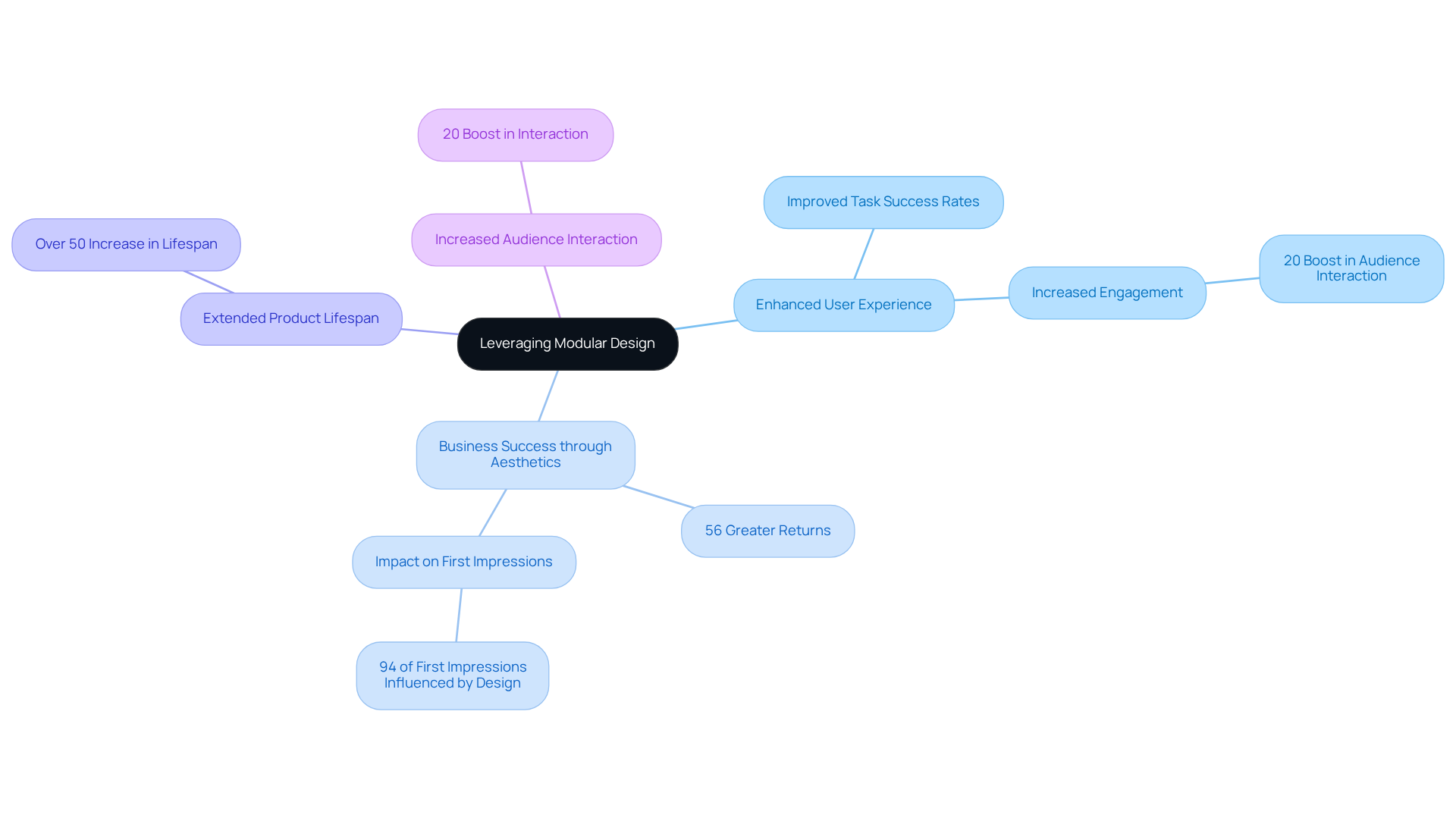
Understand the Core Principles of Modular Design
In the fast-paced world of technology, many startups grapple with the challenge of product development. The pressure to innovate while managing resources can often feel overwhelming. This is where design for modularity comes into play, providing a nurturing solution that can alleviate some of these burdens. By focusing on essential principles such as standardization, reusability, and component independence, the design for modularity allows each module to operate autonomously while integrating seamlessly with others. This flexibility is not just a technical advantage; it’s a lifeline for startups, allowing them to respond swiftly to changing market demands and user preferences.
Imagine the relief of optimizing your development processes, leading to improved product quality and efficiency. Startups that embrace these principles often find themselves on a smoother path. In fact, projects that adopted flexible design principles reported an average of 45% savings in overall project timelines. That’s a significant benefit that can transform the way you approach development.
Furthermore, 71.4% of companies committed to prefabricated construction have reported notable schedule benefits, underscoring the effectiveness of these techniques. The ability to repurpose components not only reduces waste but also enhances cost-effectiveness. In the construction sector, for example, prefabricated methods have been shown to yield higher ROI and minimize material loss. With the construction industry producing four pounds of waste for every square foot of new building space, the importance of cannot be overstated.
Standardization and reusability are not just theoretical concepts; they are practical strategies that can significantly enhance your product development efforts through design for modularity. By nurturing these principles, you can create a more sustainable and efficient process, ultimately leading to greater success for your startup. Remember, you are not alone in this journey—many have walked this path and found their way to success by embracing these caring and supportive design principles.
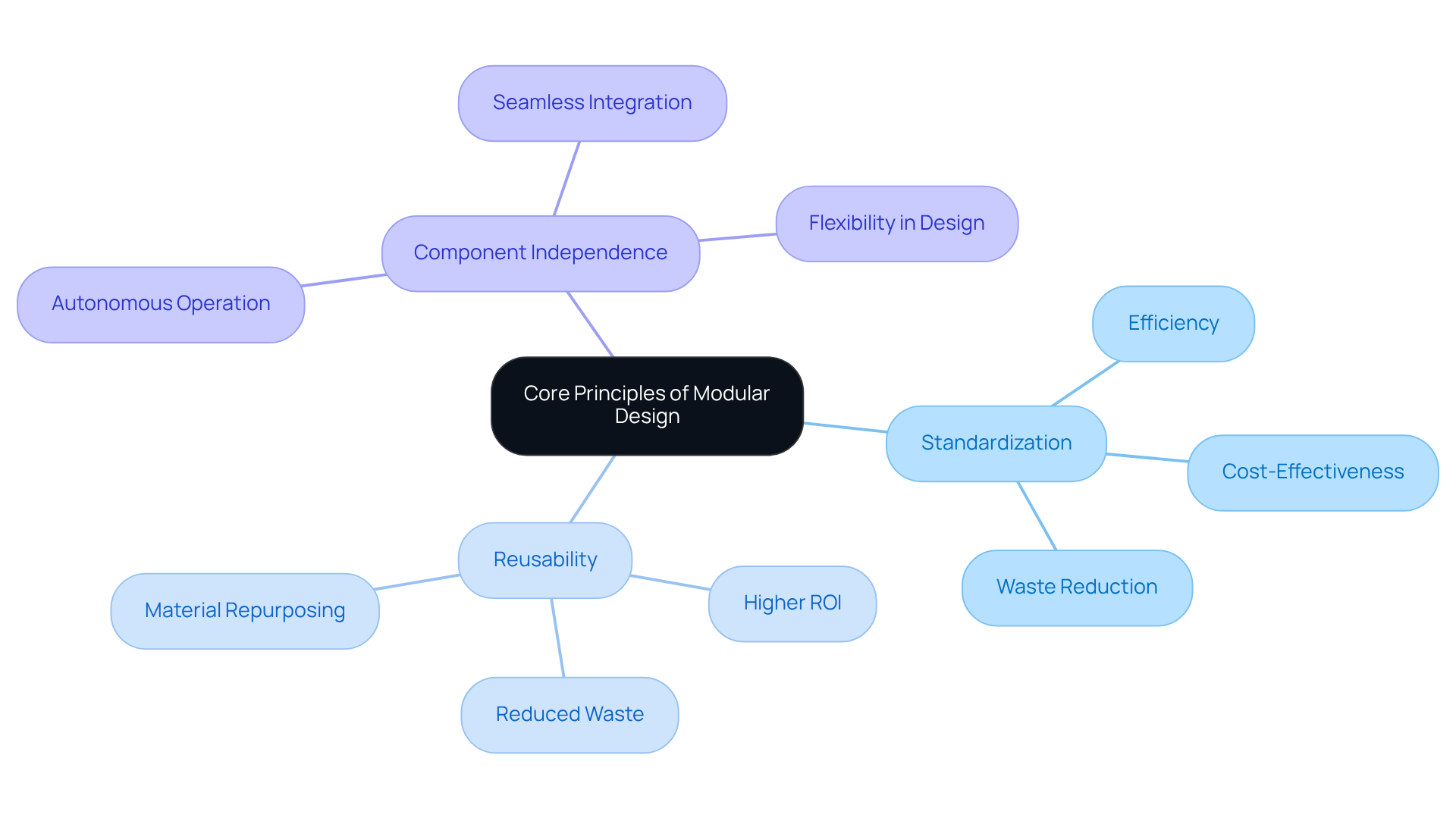
Explore the Benefits of Modularity in Product Development
In the fast-paced world of product development, many founders face the daunting challenge of lengthy development cycles. This can lead to frustration and delays that hinder progress. Imagine the relief when teams can work on different modules simultaneously due to the design for modularity, allowing for faster development and a more efficient process. Furthermore, the flexible structure that incorporates a design for modularity can significantly lower expenses. By reusing existing elements, you can minimize the need for extensive redesigns, easing the financial burden that often weighs heavily on startups.
Design for modularity enhances scalability, which is another crucial aspect. As your business grows, the design for modularity allows for the easy addition of new features or updates without the need to overhaul the entire system, which becomes invaluable. This flexibility is not just a luxury; it’s a necessity in today’s competitive tech landscape, where are paramount for success.
We understand how overwhelming it can feel to navigate these challenges alone. That’s why embracing modularity can be a nurturing solution, offering you the support you need to thrive. By fostering a design for modularity, you position your startup to adapt and grow with confidence, ensuring you remain agile in the face of change. Remember, you’re not alone in this journey; we’re here to support you every step of the way.
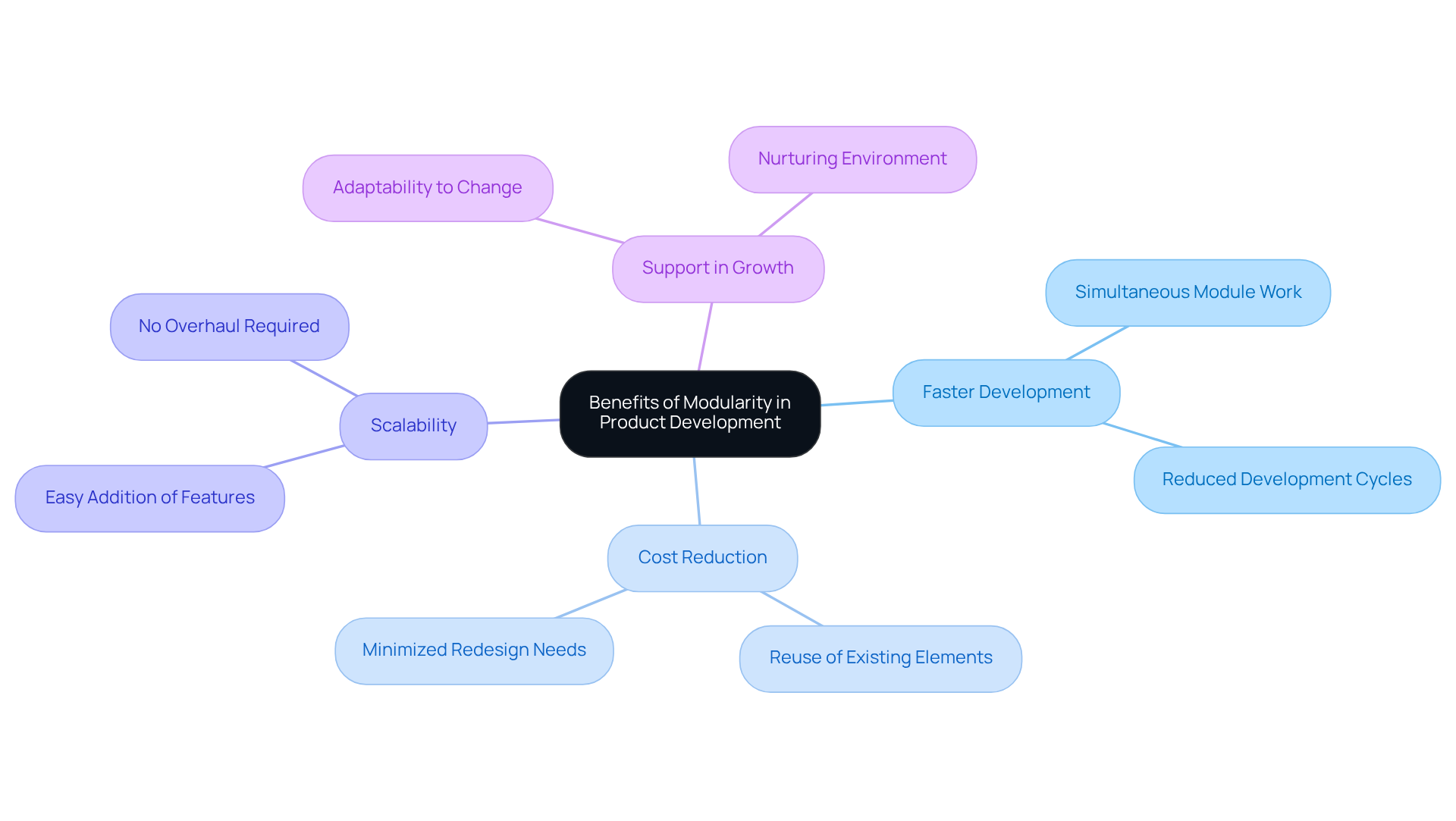
Identify Challenges in Implementing Modular Design
Navigating the challenges of adopting a flexible structure can be daunting for startups, yet these hurdles are essential to overcome to reap the benefits. One significant concern in the design for modularity is ensuring compatibility between different modules. This requires careful planning and adherence to standardized protocols, as misalignment can lead to frustrating setbacks in product development when implementing a design for modularity. Moreover, the complicates the process of managing dependencies among modules, making clear communication and coordination vital for teams.
Investing in team training is not just beneficial; it’s crucial for fostering a flexible mindset. This may even necessitate a cultural shift within the organization. Startups that prioritize this training often find they can enhance their adaptability and responsiveness to market demands. By proactively addressing these challenges, you can streamline the implementation process and achieve improved outcomes. For instance, firms that have effectively embraced flexible structures report a remarkable 40% time benefit compared to traditional methods, showcasing the potential for efficiency when compatibility challenges are thoughtfully managed.
Additionally, consider the remarkable impact of prefabricated construction techniques, which are known to reduce waste by 50% compared to conventional building methods. As the prefabricated building sector continues to grow, valued at $87.6 billion in 2022 and projected to expand at a CAGR of 7.1% until 2030, the lessons learned from these methods can greatly inform new ventures in technology. By understanding and overcoming compatibility challenges, startups like yours can position themselves for sustainable growth and innovation by implementing design for modularity amid an increasingly competitive landscape. As highlighted by Grand View Research, the global prefabricated construction market is expected to grow significantly, further emphasizing the importance of adopting prefabrication principles.
In this journey, remember that you are not alone. Embracing these insights can pave the way for a brighter, more efficient future for your startup.
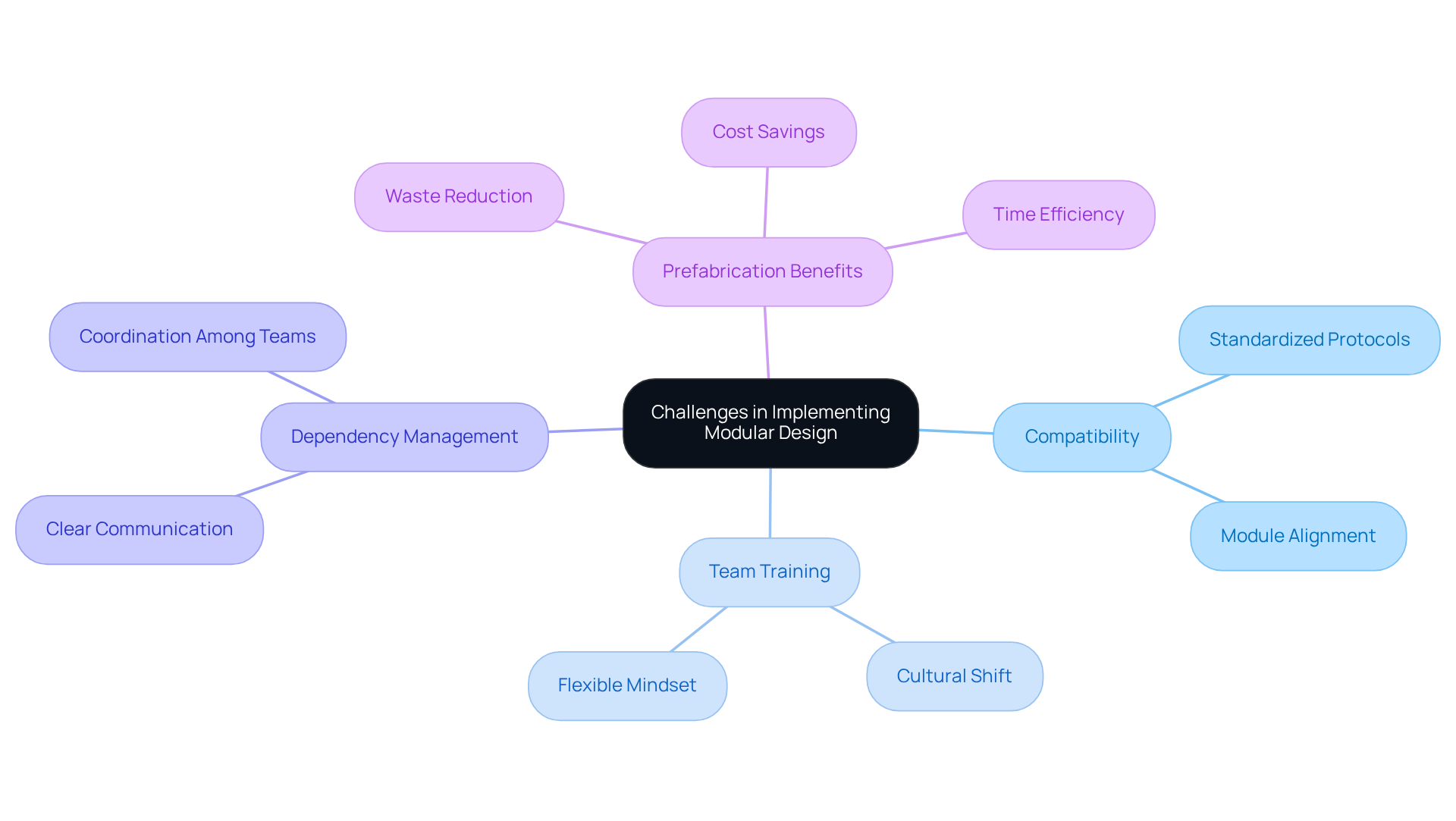
Analyze Successful Case Studies of Modular Design in Tech
In the fast-paced world of technology, many founders face the daunting challenge of creating products that truly resonate with users. This struggle can often lead to frustration, as they seek ways to and stand out in a competitive market.
Fortunately, several tech firms have effectively adopted design for modularity, paving the way for substantial improvements in their products. Take, for instance, Google’s Pixel smartphone, which showcases a design for modularity that allows individuals to personalize their devices with swappable parts. This not only meets customer needs but also fosters a sense of ownership and satisfaction.
Similarly, flexible software architectures that incorporate design for modularity, like those utilized by Spotify, enable quick feature deployment and updates, ensuring that users feel valued and heard.
These inspiring examples illustrate how flexible structures not only enhance customer satisfaction but also nurture innovation and market competitiveness. By adopting such approaches, tech startup founders can create products that truly connect with their audience, fostering a supportive community around their brand.
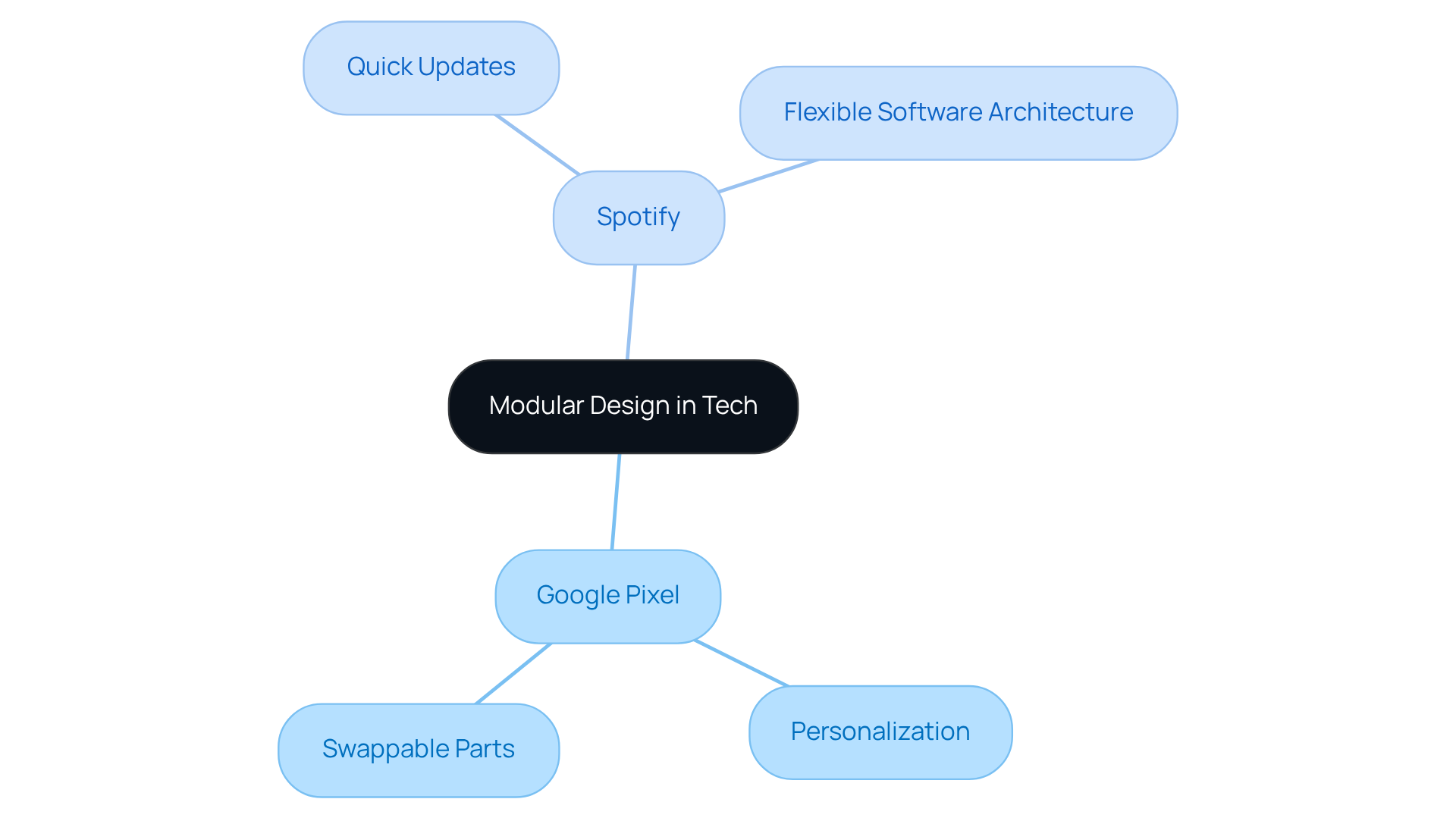
Integrate Modular Design with User Experience Principles
To enhance the efficiency of flexible structures, it is essential to combine them with consumer experience guidelines. This means designing each module with the end-user in mind, ensuring that components are intuitive and easy to navigate. Many founders face the challenge of understanding their users, which can lead to frustration and missed opportunities. Comprehensive research on users is crucial; it enables creators to comprehend needs, preferences, and challenges, greatly impacting the development process.
For instance, personas and narratives can assist in pinpointing particular journeys, resulting in more effective flexible solutions. further enhances these creations by revealing areas for improvement before launch. As Steve Krug wisely states, "If you want a great site, you’ve got to test."
By focusing on consumer experience and utilizing a design for modularity, new businesses can develop flexible products that not only operate smoothly but also captivate and please individuals, ultimately nurturing brand loyalty and improving client satisfaction. Furthermore, startups should consider conducting interviews or surveys to gather insights before initiating the development process, ensuring that their products genuinely fulfill customer requirements.
By embracing these practices, you create a supportive environment that fosters innovation and connection with your audience.
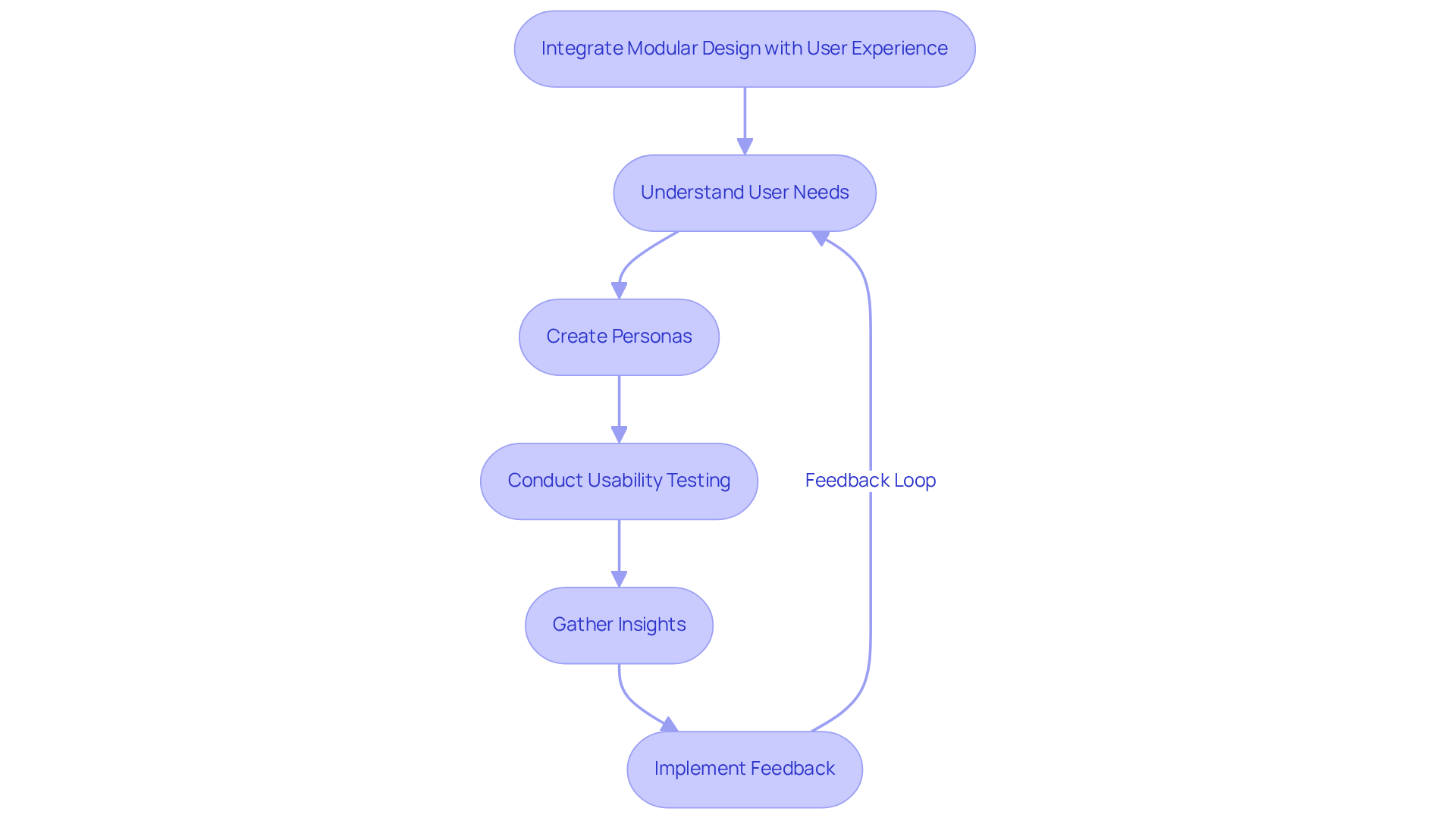
Apply Modular Design Principles in Digital Platforms
For many startup founders, maintaining digital platforms can feel overwhelming. The challenge often lies in managing complex applications that require constant updates and adjustments. When applications are not built with a , making changes can disrupt the entire system, leading to frustration and delays. This can hinder a startup's ability to respond swiftly to user feedback and market shifts, ultimately affecting competitiveness and relevance in a fast-paced environment.
However, there is a nurturing solution: implementing component-based principles by dividing applications into smaller, reusable parts. This architecture, which emphasizes design for modularity, not only simplifies updates and maintenance but also empowers teams to adapt quickly to the changing landscape. Imagine being able to modify individual modules without the fear of impacting the whole system—this approach fosters a sense of control and agility.
Establishing a framework that supports design for modularity can further enhance collaboration among team members, creating an environment where ideas flourish and innovation thrives. By embracing this strategy, startups can ensure that their products remain aligned with user needs and market demands, paving the way for sustained success.
At RNO1, we understand the journey of startup founders and are here to support you every step of the way. Together, we can navigate these challenges and build resilient, adaptable digital platforms that truly resonate with your audience.
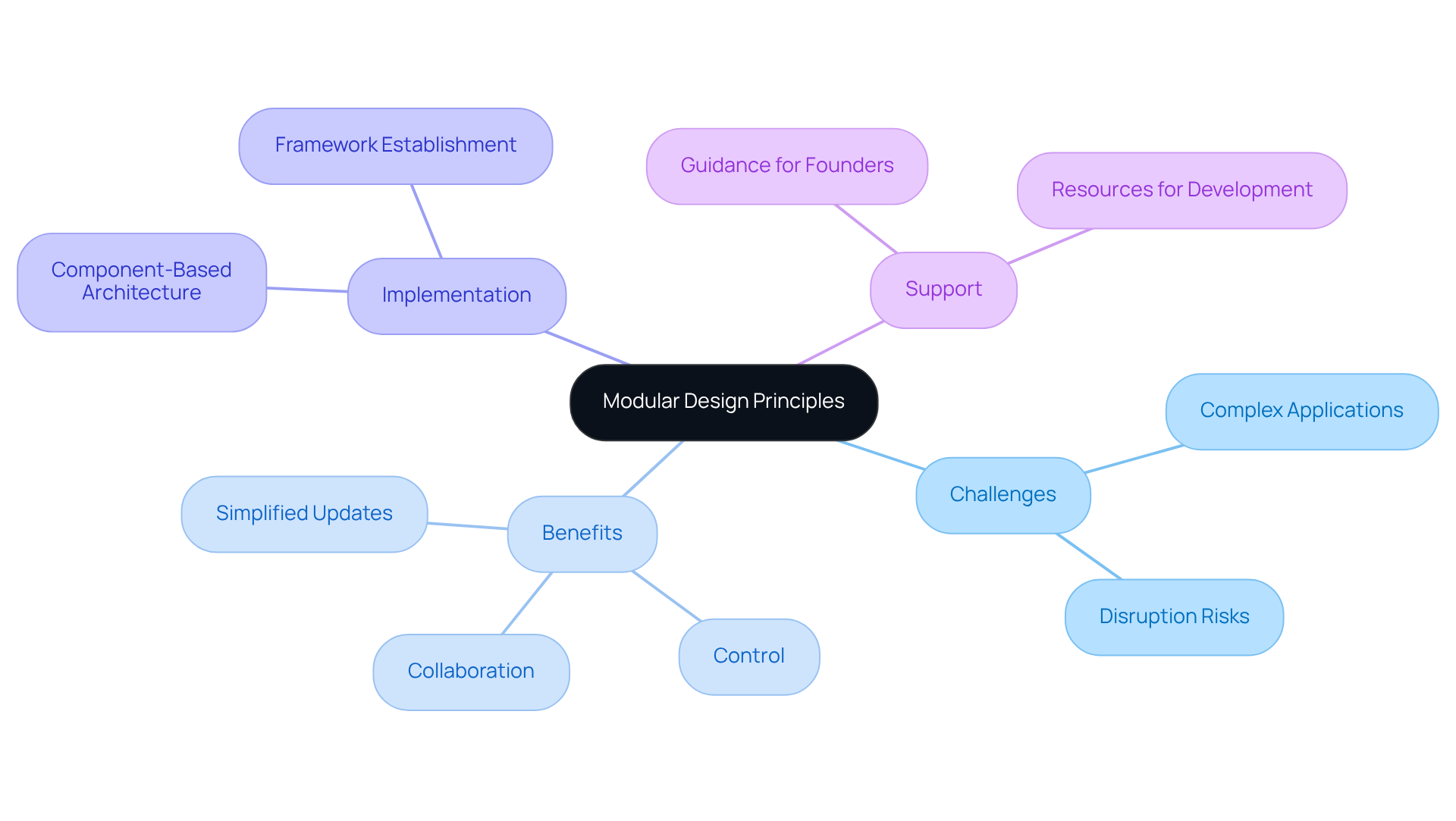
Embrace Sustainability Through Modular Design
Modular design, which embodies design for modularity, stands as a compassionate ally in our shared journey toward . It invites us to embrace the reuse of components, significantly reducing waste along the way. Imagine creating products that can be easily disassembled and reconfigured—this approach empowers startups to effectively minimize their environmental footprint.
Furthermore, we can design flexible systems that use fewer materials, enhancing their sustainability profile. For instance, adopting minimalist living can decrease household energy consumption by as much as 25%. This highlights the profound impact of our thoughtful choices.
As consumer sentiment increasingly leans toward eco-friendly products, companies that prioritize sustainability often cultivate a deeper brand loyalty. By adopting a flexible approach, not only do we contribute positively to the environment, but we also enhance our brand reputation, reaching a wider audience.
Innovative solutions, such as biodegradable packaging and energy-efficient appliances, are anticipated to pave the way for eco-friendly products in 2025. Industry leaders emphasize this vital approach; Vivienne Westwood captures it beautifully when she states, 'Buy less, choose well. Make it last.'
By incorporating design for modularity, we can play a crucial role in reducing environmental impact while meeting the growing demand for responsible products. Additionally, consider the inspiring case of a bakery that shifted to biodegradable packaging—this change illustrates how a flexible structure can yield significant environmental advantages, encouraging others to embrace similar practices.
Together, we can make a difference.
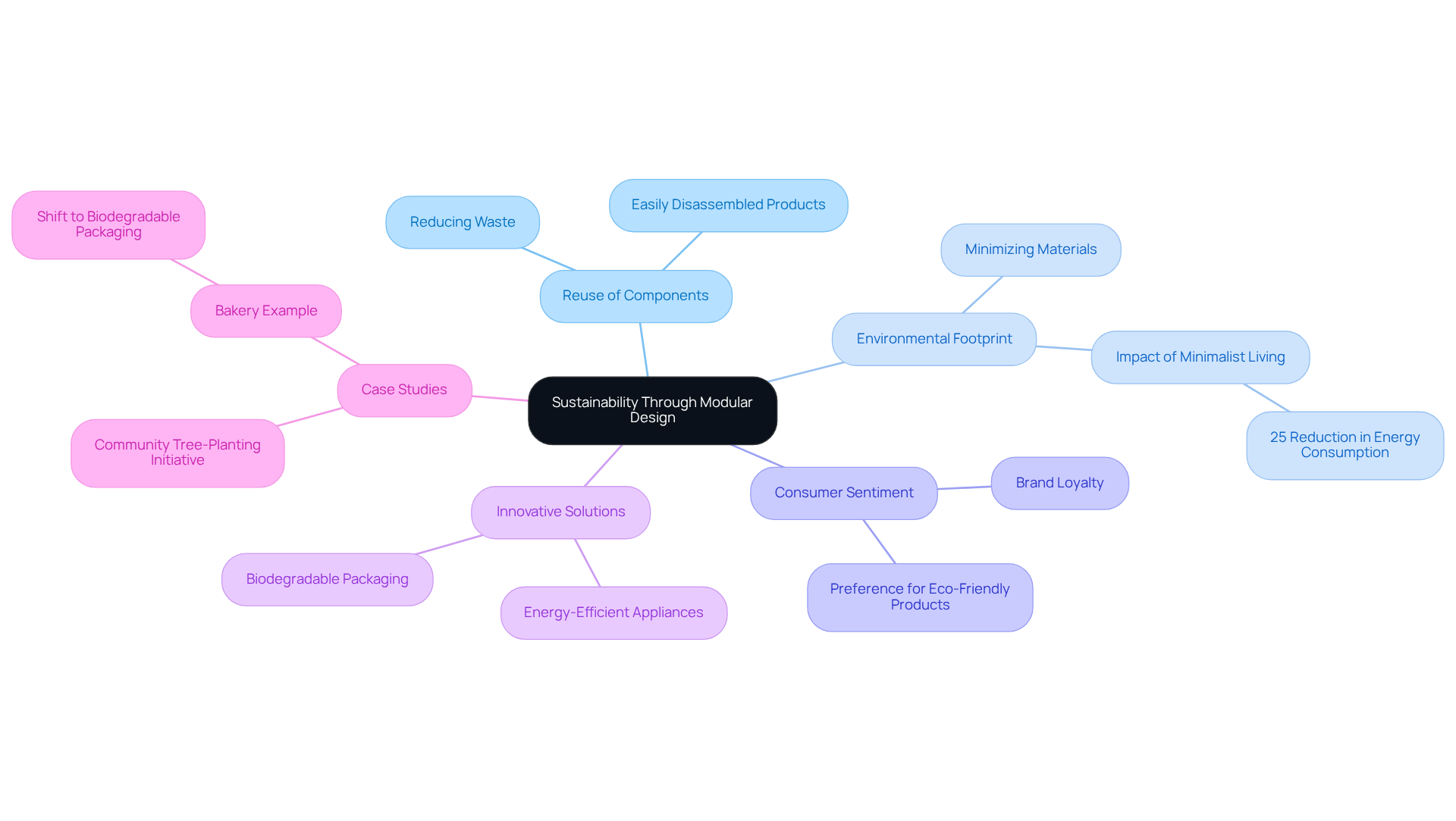
Foster Collaboration in Modular Design Processes
Collaboration can often feel like a daunting challenge in the world of modular development, especially for startups that are trying to adopt a design for modularity while navigating their unique paths. When team members struggle to communicate openly, it can lead to misalignment on objectives and standards, leaving everyone feeling frustrated and lost. RNO1 understands this pain and emphasizes the importance of fostering a culture of collaboration. By implementing strategies that deliver measurable success, we can help prevent scope creep and keep projects on track.
Imagine using collaborative tools like Figma and Adobe XD, which not only simplify the design process but also allow for immediate feedback and modifications that enhance quality. Regular team meetings and brainstorming sessions can serve as nurturing spaces for innovation, where diverse perspectives are shared and refined. These moments of connection can transform the way your team approaches challenges, making everyone feel valued and heard.
By prioritizing teamwork and utilizing the right tools, along with RNO1's supportive cross-functional groups, new ventures can implement a design for modularity to create cohesive and impactful component constructs that truly resonate with client requirements and business goals. We believe that together, we can build a brighter future for your startup, one where and fulfillment.
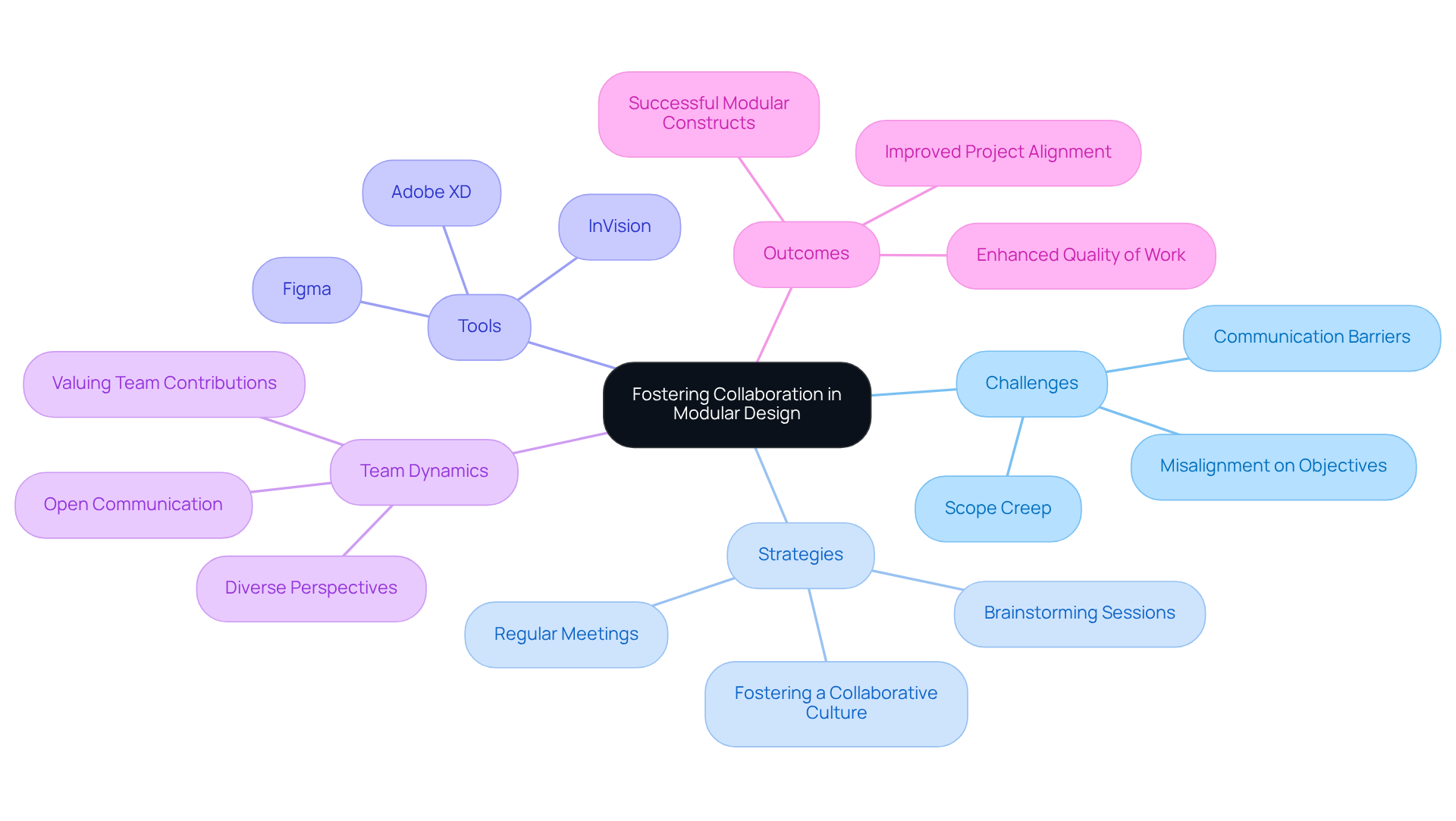
Stay Informed on Trends in Modular Design
In the journey of technology new ventures, the challenge of sustaining a competitive advantage can feel overwhelming. The ever-changing environment of flexible structures demands our attention. It's essential to stay informed about technological advancements, shifting consumer preferences, and the best practices within the industry. Engaging with professional networks, attending industry conferences, and following influential thought leaders can provide invaluable insights that help navigate these complexities.
Moreover, regularly assessing component-based strategies is crucial to ensure alignment with contemporary trends and user expectations, particularly in the context of design for modularity. This continuous learning and adaptation not only fosters innovation but also enhances product offerings, allowing startups to position themselves effectively in a rapidly evolving market. As Nikki Wilson insightfully notes, "This approach is pivotal in enhancing productivity, reducing costs, and fostering growth across businesses."
With the projected to reach USD 2.5 billion by 2033, understanding design for modularity trends becomes increasingly important. By prioritizing knowledge and connection, technology new ventures can not only survive but thrive, creating a brighter future for themselves and their communities.
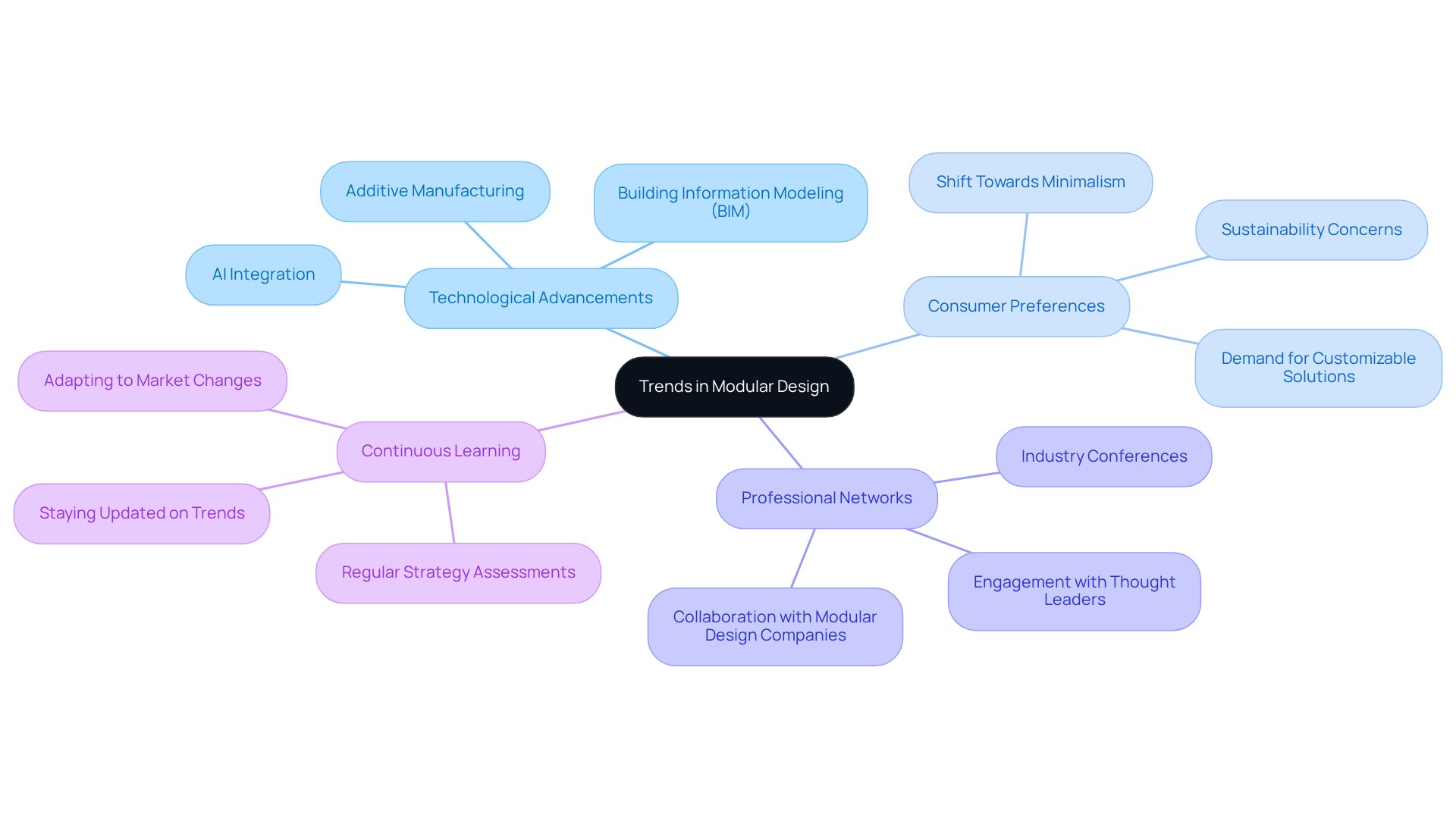
Conclusion
Navigating the complexities of product development can feel overwhelming for tech startups in today’s fast-paced digital landscape. The challenge lies not just in creating innovative solutions but in ensuring those solutions are adaptable and responsive to ever-changing market demands. This is where embracing modular design becomes a beacon of hope. By focusing on design for modularity, startups can cultivate flexible, scalable solutions that enhance user experiences and drive innovation. This strategic approach empowers businesses to pivot quickly, ensuring they remain relevant and competitive.
Throughout our exploration, we’ve uncovered essential insights into core principles like:
- Standardization
- Reusability
- Component independence
Consider the inspiring journeys of companies like Google and Spotify, whose success stories illustrate the profound impact of modular design on customer satisfaction and operational efficiency. Additionally, the commitment to sustainability through reduced waste and optimized resources highlights the broader benefits of adopting modular strategies.
Ultimately, the path to effective modular design is rooted in collaboration, continuous learning, and adaptation. By nurturing a culture of teamwork and staying attuned to industry trends, tech startups can unlock the full potential of modular design. This journey not only paves the way for sustainable growth but also fosters a lasting positive impact within the digital realm. Embracing these principles positions businesses for success while contributing to a supportive community and a healthier environment.
Frequently Asked Questions
What is the main focus of RNO1 in the digital landscape?
RNO1 focuses on leveraging design for modularity principles to create flexible and scalable digital experiences tailored to meet the changing demands of the market and consumer preferences.
How does design for modularity benefit startups?
Design for modularity allows startups to break down complex digital products into manageable modules, enabling them to respond quickly to market changes and user needs, ultimately improving product quality and efficiency.
What are some core principles of modular design?
The core principles of modular design include standardization, reusability, and component independence, allowing each module to function autonomously while integrating seamlessly with others.
What advantages does modular design offer in product development?
Modular design enables teams to work on different modules simultaneously, leading to faster development cycles, reduced expenses through the reuse of existing elements, and enhanced scalability for easy updates as the business grows.
How does effective aesthetics impact business success according to the article?
Research indicates that companies prioritizing aesthetics achieve 56% greater returns compared to their peers, highlighting the importance of effective aesthetics in driving business success.
What impact can modular structures have on audience interaction?
The effective application of modular structures can boost audience interaction by as much as 20%, emphasizing the significance of design for modularity in the digital realm.
What are the reported benefits of adopting flexible design principles in projects?
Projects that adopted flexible design principles reported an average of 45% savings in overall project timelines, showcasing the efficiency gained through modular design.
How does modular design contribute to sustainability in the construction sector?
In the construction sector, modular design techniques help reduce waste and enhance cost-effectiveness, yielding higher ROI and minimizing material loss during development.
Why is it essential for tech startups to embrace modularity?
Embracing modularity is essential for tech startups to remain agile, adapt to changes quickly, and ensure they can grow and innovate in a competitive landscape.




